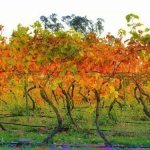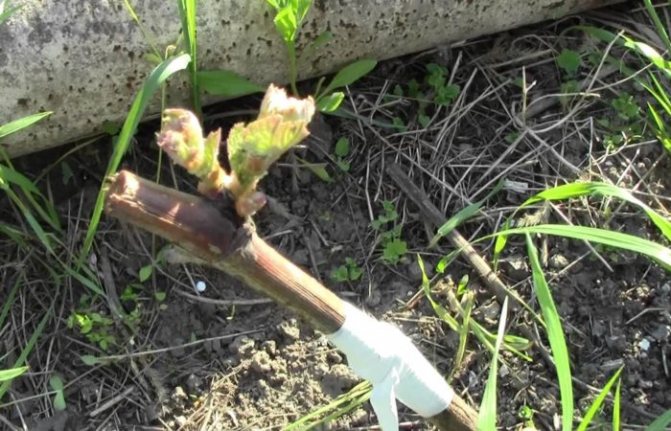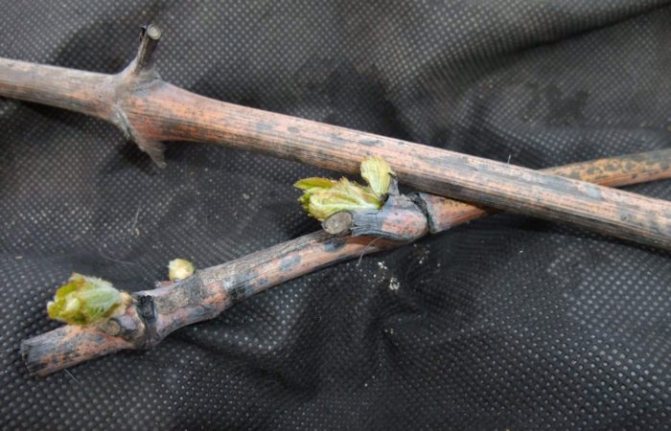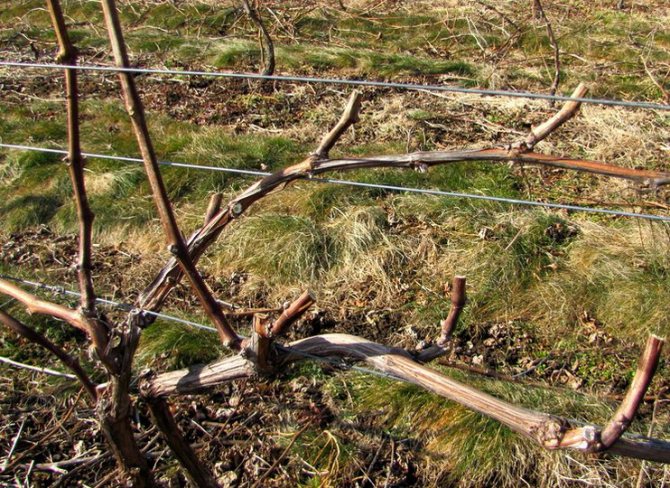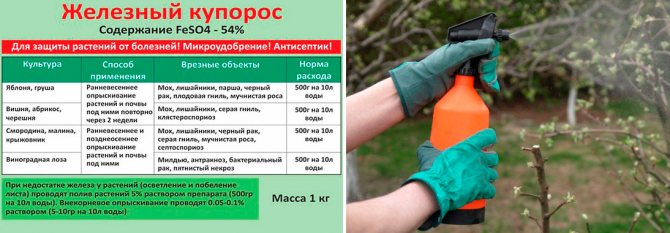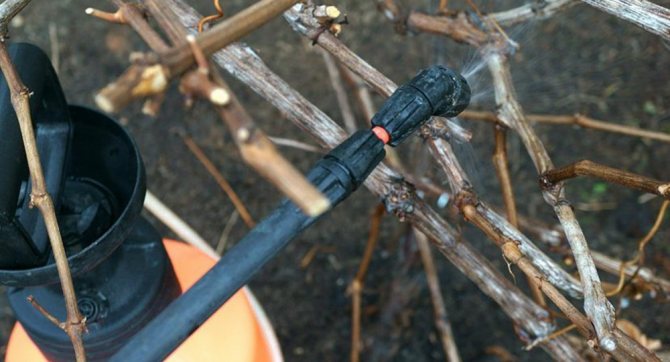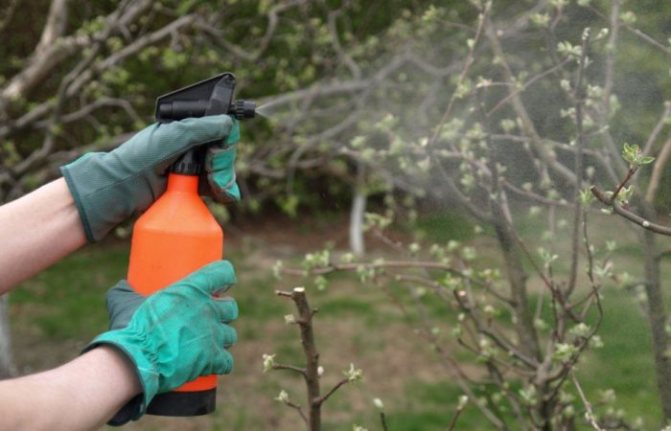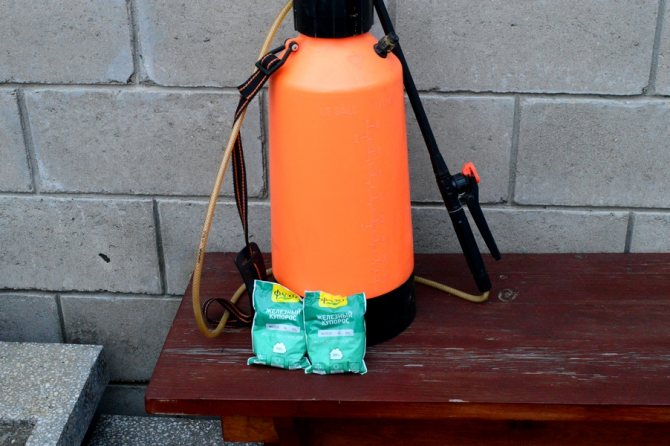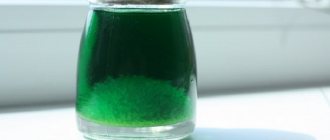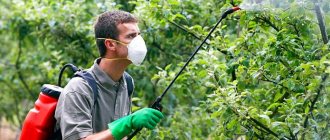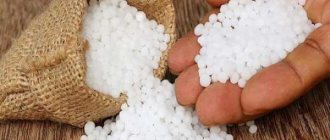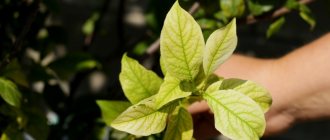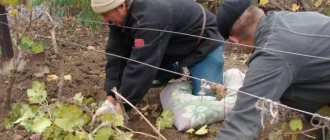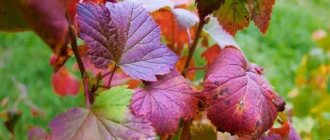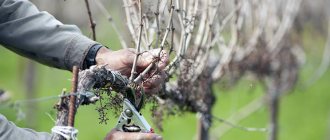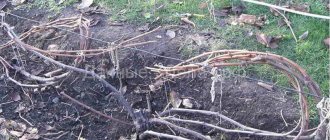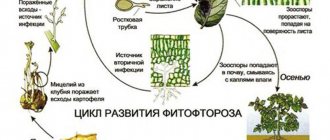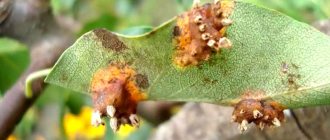The value of ferrous sulfate for grapes in autumn
In the fall and spring, experienced growers use iron vitriol to treat bushes.
It is used as a protection, prevention and treatment against certain fungal diseases and as a fertilizer. Ferrous sulfate contains the necessary amount of iron for the plant. This is the most beneficial remedy.
Determination of iron deficiency in grapes can be based on the following characteristics:
- Young leaves of grapes turn white and crumble;
- Shoots develop poorly;
- Bunches of grapes do not develop even in comfortable weather conditions.
By treating grapes with iron vitriol, two effects are achieved:
- prevention and treatment of fungal diseases;
- fertilization of the root system.
- iron sulfate is used to treat grapes in order to combat:
- mildy;
- anthracnose;
- bacterial cancer;
- spotted necrosis;
- grape cushions;
- oidium and other diseases.
For this purpose, a kilogram of vitriol is added to 15 liters of warm water.
If you seriously approach the treatment of bushes, the lichen completely disappears by the middle of summer, and after a year the bark will acquire elasticity.
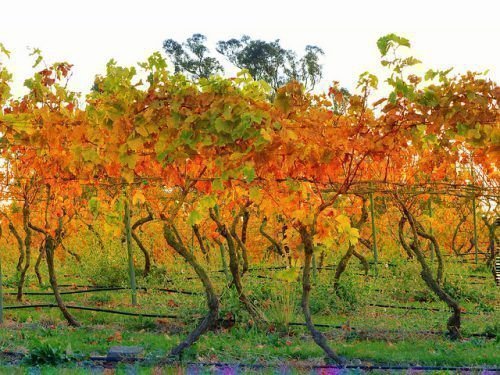
Autumn spraying of grapes is used for the prevention and treatment of its diseases.
Advantages and disadvantages of the drug
The substance is used in horticulture due to the following qualities:
- The effect after the treatment of the culture persists for a long time.
- Low cost.
- Wide range of applications.
- It is spent sparingly, and the acquired stocks will last for a long time.
- After applying the vitriol solution to the product, its use in food is possible earlier than when processing with other drugs.
Disadvantages:
- it is difficult to determine the required dosage by eye, and when drawing up a solution, it is required to be guided by clear rules;
- if the liquid is too saturated with vitriol, instead of protecting against pests, you will burn the bush.
The substance belongs to the 3rd class of hazard, i.e. low-hazard to humans. Does not spontaneously ignite, does not explode. When a large amount enters the human body, general poisoning, upset of the digestive system and irritation of the skin and mucous membranes are observed. Urgent medical attention is required.
Irrigation must be carried out in calm weather, wearing personal protective equipment.
Stored in a hermetically sealed package for an unlimited amount of time. It is advisable to use the open one as soon as possible, to protect from dampness.
Advantages of the drug:
- Not toxic to humans, plants and animals (in moderate doses).
- Replenishes iron deficiency.
- There is a high efficiency against fungi.
- Long shelf life.
- Relatively low cost of the drug.
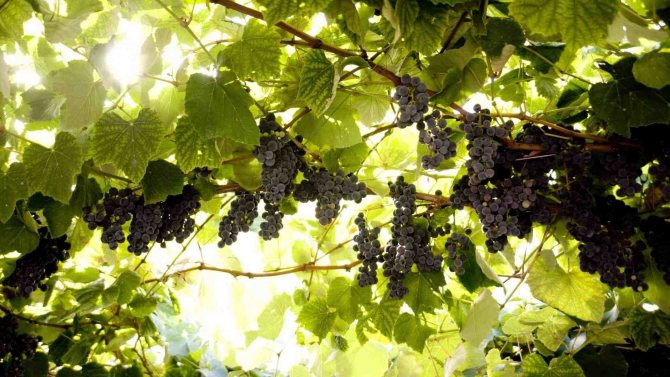

Despite the many advantages, the drug still has a small list of disadvantages.
- With a decrease in concentration, it does not work.
- Processing time limits.
- The formed film is easily washed off by rain.
- An overestimated concentration of the active substance can leave burns on plants.
- Efficiency against viral and bacterial diseases is low.
Iron vitriol is a very effective micronutrient fertilizer, which is effective in the prevention and treatment of various diseases and pest attacks.Plants can be saturated by irrigation or by digging into the soil in autumn and spring.
Iron vitriol is justifiably included in the list of the most demanded drugs. When used correctly, it provides good and consistent results. Before use, be sure to read the instructions for use.
Grape processing
The first time the grapes are thoroughly sprayed in the spring, when the buds have not yet formed.
The second time, processing is carried out in late autumn after pruning before frost.
In the spring, the grape bush is treated with a solution of 0.5% ferrous sulfate. This is 50 grams of top dressing per 10 liters of water. This is done before bud break.
In autumn, spraying is carried out in the second half of October or in November.
An autumn solution of ferrous sulfate is made with the calculation of 3% for a young culture and 5% for a mature bush. So, in 10 liters of water, 300 g or 500 g of ferrous sulfate are diluted.
The property of ferrous sulfate is the formation of a thin film after drying, which slightly tightens the bark of the vine after drying. This is what prevents the development of many fungi. But it is not the main antifungal agent. In most cases, it protects against lichens and mosses.
Due to the creation of a thin film, ferrous sulfate is used in the autumn from late frosts.
Treated bushes in spring bloom two weeks later than untreated bushes.
The formed film after spraying does not allow the buds to open earlier. During this time, callus is formed on the lower cut, which contributes to the appearance of roots, and this significantly increases the development of the seedling.
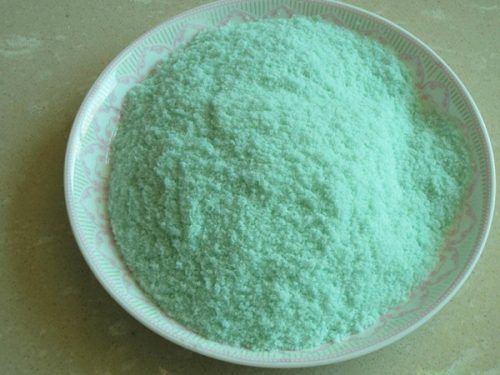

For spring treatment, a solution is used at the rate of 50 g per 10 liters of water
The use of iron sulfate in viticulture
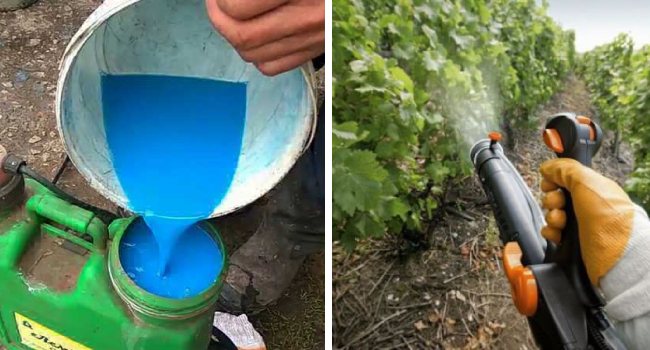

Iron sulfate for the vineyard
Ferrous sulfate is used in viticulture in many cases. The same product can be used several times a season for pest control, feeding, disinfection, cutting cuttings and other purposes. Choose the right proportions for different purposes. The same solution is not suitable for treating wounds and for fighting moss.
It is necessary to process the vine 1-2 times in the spring. Mix 150 g of crystals and 10 liters of water. It is necessary for all the particles to dissolve. Spraying method is used. Already infected plants can be cured with iron sulfate. For this, a stronger 3% solution is used. You can not spray the agent on the buds and opened leaves, therefore, the treatment is carried out in early spring or late autumn.
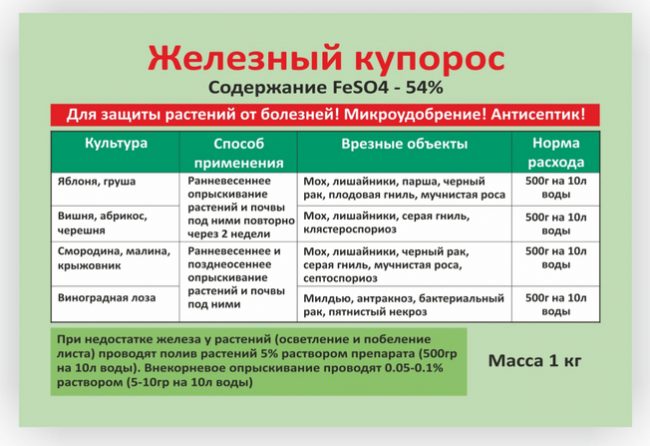

Table with methods of application and consumption rates of ferrous sulfate
Experienced gardeners feed the soil with a 0.1-0.2% solution of vitriol (1-2 g of crystals per liter of water). In dry, calm weather, before the first leaves appear, fertilizing can also be carried out by spraying. In the spring, vitriol crystals are added directly to the soil next to the root.
The vine, although elastic, can still break under the influence of external factors. Cracks and wounds are treated to protect against bacteria or viruses. Iron vitriol is stirred in water in a ratio of 0.1 to 10, that is, 0.01 l (10 ml) of ferrous sulfate will be needed for 10 liters of water. Processing rules:
- It is most convenient to handle the affected area with a brush.
- If the weather is rainy, then this will have to be done every day, since a thin film comes off under the influence of water.
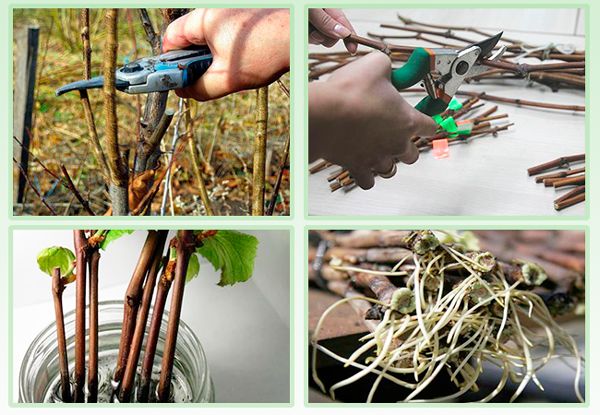

The result of using iron sulfate is roots on cuttings
Before planting the cuttings, the upper part is treated with a solution containing iron sulfate. Although this will slow down growth, it will strengthen the root system. It will be a sturdy plant that is much more likely to survive and withstand the winter cold.For processing, take a 0.5% solution and a soft brush or cotton swab.
The 3% solution helps in the fight against mosses and lichens. Processing is needed several times in the spring or autumn. Spray only the bottom of the trunk so that the product does not get on the leaves. After spraying the mosses, the lichen is harvested by hand. Iron vitriol weakens the root system of mosses, prevents them from multiplying further.
Iron sulfate is used for grapes in autumn and spring as a nutrient solution. As mentioned above, this is the best drug to date, in which the maximum amount of iron necessary for berries and fruits is concentrated.
For foliar spraying, a concentrated solution is used, which is prepared at the rate of 10:15, that is, 15 g of the drug is taken for 10 liters of water. Feeding is done after the snow melts or before the onset of the first frost.
When is it better to process a bush in spring or autumn?
Autumn treatment of the bush with vitriol is the most effective protection against impending frost. If the disease is noticed before autumn, it is necessary to immediately process the plant. Otherwise, when the cold weather comes, the bush will completely die.
Why is it better to prevent grapes from diseases in the autumn? In the spring, this will be much more difficult to fight.
The good development of a grape bush depends on how it has wintered. The best shelter will not save you from illness and the plant will die in the spring. Therefore, in the autumn, proper preventive treatment is needed. Since fungi are capable of destroying the culture under cover. In the spring, the bush will be very weakened.
It is important to know that if healthy leaves hang on a grape bush for a long time, this means the best supply of nutrition for the bush for the winter.
Processing of grapes in the fall is done after harvest and when the leaves have completely fallen. If there are painful shoots, they are removed before processing. This is often combined with the vine's fall shelter. Every year they fertilize with organic fertilizing: compost, manure, nitrogen, phosphorus, potassium. And the cut off shoots are sprayed with 5-7% ferrous sulfate: 500-700 g of vitriol is mixed in 10 liters of warm water.
It is the concentrated treatment that effectively removes the disease from the surface of the bark. But this does not interfere with pests and "curly" infections. Ferrous sulfate treatment primarily prevents winter mold.
After spraying the vine with iron vitriol, the vine will darken. In places of powdery mildew disease, there will be black spots. Before processing, nothing is visible, the vine has a uniform brown color. Oidium develops imperceptibly and it is possible to notice it only after spraying.
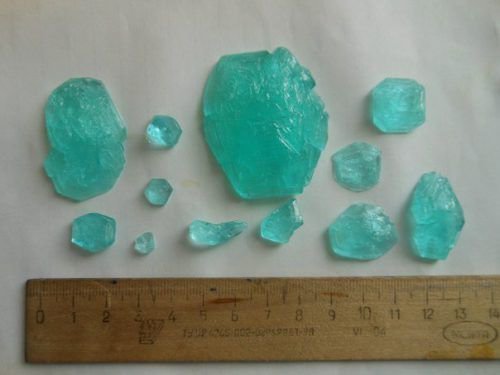

Ferrous sulfate - a means of preventing winter mold
Benefits of processing with iron sulfate
Iron vitriol is an excellent remedy to improve the productivity of bushes and trees. Among winegrowers and gardeners, this is one of the most popular remedies. And beginners, out of ignorance, do not often use this tool. Ferrous sulfate, in addition to its benefits, is a very affordable remedy.
It is ferrous sulfate that can supply the culture with iron in an easily digestible form.
Experienced farmers understand the importance of iron for plants - it actively participates in their respiratory system.
Iron vitriol consists of green crystals, therefore it is often called "green vitriol". It is completely harmless to humans. However, it is advisable to use rubber gloves, a respirator, and glasses during processing. Old vines need to be sprayed with green vitriol. This relieves them of mosses, lichens, and prevents the development of scab.
Description of the drug
The substance obtained by the interaction of sulfuric acid with ferrous molecules is made in the form of turquoise salt crystals. It dissolves well in cold water and is used to combat diseases and pests on grapes.It can be used as a mineral fertilizer in case of insufficient iron content in the soil. Iron vitriol for grapes is used all over the world as a means of fighting diseases. Not dangerous for humans and pets. The instructions on the package with iron vitriol will help you make the best solution for the autumn processing of grapes.


Composition and active substance
Copper sulfate is a powdery substance that has a light blue or blue color. It dissolves well in liquid, because there are 5 water molecules per 1 molecule of copper sulfate. The formula of the substance is as follows - СuSО4 * 5H2O. The substance is not safe for the human body and has category 3.
Note! Vitriol enters the human body through the skin and mucous membranes. Beware of direct contact with him, because this is fraught with consequences. Do not forget about safety rules when working with it.
How to breed?
To carry out the processing of grapes, to combat diseases and pests, it is important to know how to breed iron vitriol. The substance dissolves well in water, so it is enough to pour it into a bucket (10 l) and fill it with water. After mixing the mixture well, pour the diluted fungicide into the sprayer and start processing the bushes.
Treating the vineyard in the fall is often required at low temperatures, so it may be necessary to use hot water to prepare the solution. The vine is processed, so the concentration of ferrous sulfate can be increased, especially when working with old bushes.
Terms and conditions for processing
You can spray the vines at any time of the year except winter.
- It is necessary to use iron vitriol for grapes in spring in April, until the buds begin to swell. Its use helps prevent disease and strengthen the vines for increased yields. It is imperative to remove winter shelters before the procedure.
- In the summer, the procedure is carried out mainly in the evenings, most often at this time vitriol is taken in order to fertilize and eliminate the manifestations of chlorosis.
- In autumn, processing is appropriate only after harvesting before the frost sets in, the procedure helps prevent iron deficiency and eliminate all parasites lurking inside the bark.
Attention! It is possible to work with vines in autumn only after complete removal of foliage and damaged parts.
When using vitriol, the formation of buds is suspended, this must be taken into account, since after processing in the vineyards a special film appears, which retards the development of the culture for fourteen days.
Solution concentration
Depending on the purpose of spraying, solutions are prepared with different contents of the fungicide: • if you want to destroy harmful microorganisms, you will need to dilute 400-450 g per bucket of water; • when processing to combat lichen or moss, add 300 g of sulfate per 10 liters; • if there is a lack of iron and foliar feeding is carried out on the leaf, 15-20 g of the substance is diluted in a bucket of water; • if the grapes are affected by chlorosis, the bushes are treated with a solution of 5 g of the substance per bucket of water; • to apply root dressing in the fall, it is enough to pour 100 g of vitriol per m2 before digging.
Rate when spraying grape bushes
During the autumn spraying of grapes, it is not required to dilute a large amount of the solution at once. Taking into account that the work is carried out on the vine, without processing the foliage, the rate of consumption of vitriol is 10 liters of solution per 100 m2 of area. For a small garden plot with a small vineyard, 10 liters will be enough, but if the solution remains, it can be used to process trees or the soil around the bushes.The main thing is to maintain the proportions of the content of ferrous sulfate and water, abundantly sprinkling all parts of the plant, especially the depressions in the bark of the old vine. A solution of ferrous sulfate is prepared for spraying grapes in sufficient quantities, with a small margin. If the processing area of the vineyard is 130-140 m2, it is better to make 2 buckets of solution, treat the plants abundantly, and use the remainder to spray fallen leaves or fruit trees on the site.
When iron sulfate is used
Iron vitriol for grapes in the fall is one of the most important plant treatments for diseases. Autumn spraying of grapes with iron sulfate is carried out after the foliage has fallen from the bushes. 10-15 days after the leaves fall, the growers begin to prune the excess growth and prepare the bushes for shelter for the winter.
If you carry out earlier processing, the process of photosynthesis and accumulation of nutrients in plant cells will not be completed. If you move the pruning period, the risk of damage to the bushes by the first frosts increases. After pruning, harvesting fallen leaves and cut off shoots, you can start the autumn treatment of the bushes with a fungicide. The concentration of the substance depends on the age of the bushes:
- for the treatment of young bushes, it is better to prepare a 3% fungicide solution. To a bucket of water, add 300 g of vitriol;
- treatment with a 5% solution of old grape bushes will be required. Autumn work is important not only for the affected vine bushes, but also as a prevention against infection of healthy plants. By cultivating the vineyard in the fall with iron sulfate, gardeners help to reduce the likelihood of diseases and pests on the site in the spring.
Appointment
The range of applications in horticulture is wide. So, vitriol is used for:
- feeding the bush;
- processing plants from fungal infections;
- processing of grape cuttings to strengthen immunity;
- disinfection of damaged areas of the bush.
Each method requires an individual approach and adherence to the rules specified in the instructions for use.
Top dressing
Novice gardeners are wondering if this substance can be used as a top dressing? Yes it is possible. Vitriol, as a fertilizer, is effective in the case of grapes growing on peat bogs and sandy soils. On chernozem, the beneficial effect of fertilizer comes to naught.
The substance feeds the developing plant with copper, helping to fight harmful bacteria and stimulating photosynthesis. Dosage for feeding: 4 grams of the substance are added to 10 liters of liquid.
Helps in the fight against the following diseases:
- powdery mildew;
- white and brown spotting;
- scab;
- effective in the fight against fungal infections.
Ingredients: water, copper sulfate, skim milk or laundry soap. Milk or soap is required to increase the effect of the drugs. If you add 100 grams of stickiness enhancer to a bucket of water, the protective film will last longer on the plant, and it will not be washed off by rain.
Processing cuttings
Saplings soaked in a 2% solution of copper sulfate are highly resistant to harmful bacteria. This procedure is carried out before planting and increases the chances of a sprout forming into a powerful, beautiful bush that gives a stable harvest.
Disinfection of wounds
To create a disinfectant solution for treating plant wounds, you need to prepare:
- 10 liters of water;
- 100 grams of substance.
Having treated the wounds of a bush or tree with the obtained medicine, you can not be afraid of their inflammation and the death of the plant.
Differences in the processing of grapes with copper and iron sulfate
The main advice for novice winegrowers is that in the spring the bushes are treated with copper sulfate after opening, and in the fall, for the processing of grapes before sheltering for the winter, it is better to use ferrous sulfate. Other differences include:
- ferrous sulfate is not used as part of a mixture with other substances, when copper is used as part of a Bordeaux liquid and in combination with pest control agents;
- no ferrous sulfate is used for whitewashing trees;
- copper sulfate fights pests better, but iron sulfate is preferable in the fight against diseases and fungi;
- the substances are not interchangeable when applying root dressing.
Grapes are an excellent horticultural culture, but growing and processing plants will require great strength and skill. A large bunch of this sunny berry will be a reward for experienced winegrowers.
Growing grapes requires knowledge of how to protect the plant from disease Only preventive measures taken on time can lead to the full development of the vine, successful and abundant fruiting. Timely feeding of the berry culture also plays an important role. Gardeners need to use iron vitriol for grapes in agricultural technology. The drug is important as a means of preventing and treating the main diseases of the fruit crop.
Use of the substance for pest control
Ferrous sulfate is used as an antiparasitic substance. A properly diluted mixture of ferrous sulfate, for spraying grapes, can quickly destroy eggs, larvae, and pests laid in the bark of plants. With a particularly careful filling of all cracks in the bark, even one operation can destroy half of all larvae.
But the main job of ferrous sulfate is to protect plants from diseases. The low insect toxicity of this drug does not allow achieving reliable results in pest control. Autumn spraying, as a preventive measure against pests, is a completely justified step, but starting in spring, it is better to use more effective preparations to fight insects.
Knowing how to properly dilute iron sulfate for spraying grapes, it is important to understand how to spray the bushes to achieve optimal results.
In the fall, just before the bushes are sheltered for the winter, grapes are processed with iron vitriol. But before that, you can apply organic fertilizer. To do this, up to 8 kg of rotted manure or compost is introduced under each bush. Pruned shoots should not be tied to fascines. For the best result, it is important to apply the solution to the entire surface of the sprouts and vines.
Necessarily, using a sieve, the vitriol solution is poured into the sprayer.
Do not forget about the use of eye protection during work. And although the solution is not toxic, it is better to use gloves and cover open skin areas. Avoid placing a large torch on the rod sprayer to feed the mix.
Each shoot and sections of the vine are filled with a solution, filling all the voids and cracks. Therefore, processing in the fall before sheltering for the winter is so important. Do not worry about the high flow rate of the solution. The cultivated soil under the bushes and the plants themselves will exclude the wintering of diseases, fungi and pests. Therefore, you should not save the solution. You can even slightly increase the concentration of the substance to 7% when processing grapes before sheltering for the winter.
What it is?
Iron sulfate is called a solution of ferrous sulfate. Iron sulfate is odorless and consists of transparent bluish-green crystals. The substance differs:
- good water solubility;
- low toxicity;
- oxidation by air;
- low degree of decomposition at high temperatures.
In industrial production, ferrous sulfate is obtained as a by-product when iron sheets or wire are etched with sulfuric acid to remove scale.
You can prepare the substance yourself by acting on scrap iron with a dilute solution of sulfuric acid.
The use of ferrous sulfate is extensive. In addition to agriculture, it is needed as a medicine for patients with iron deficiency anemia.Serves as a tool for dyeing fabrics, ink production.
Iron vitriol is produced in the form of a crystal-like powder, in packages weighing 150 grams.
How to process vines with vitriol according to the rules after opening
For the first time, it is recommended to do the treatment in early spring. A weak vitriol solution is best suited for this procedure. The second procedure is applied in the fall, before the first frost occurs. At each spraying, a fresh solution is used, which can be filtered with gauze, if necessary, so that the substance is evenly mixed with water.
As a top dressing
Correct use of vitriol in the form of top dressing is permissible in order to compensate for the lack of substance in the roots. To do this, make a solution consisting of two teaspoons of ferrous sulfate and a tablespoon of lemon acid in combination with water. After preparation, the composition is watered with the area in the root growth zone, carrying out such a top dressing once every ten days.
For reference! It is suitable not only for mature plants, but also for seedlings that have recently sprouted.
If we are talking about seedlings, the proportions need to be reduced, in this case, one spoonful of sulfate and half a spoonful of lemon acid will be enough for three liters of water.
Before applying top dressing, the soil at the roots is loosened for deeper penetration of the active substance into the root zone. If the leaves remain green, this means that the vine does not yet need active feeding and is able to cope with diseases or parasites on its own.
Mechanism of action
Since crystals of ferrous sulfate are obtained by the action of sulfuric acid on iron, they are used when necessary:
- replenish the number of atoms of an important substance in plant tissues;
- fertilize the soil;
- destroy pathogenic microorganisms;
- take measures to combat chlorosis.
The crystals contain so much iron that if it is lacking, it can be replenished by 1-2 spraying procedures with a solution.
Given the low toxicity of the substance, it is used only for preventive purposes in the fall. The treated plants will be protected from fungal infections. But vitriol has a weak effect on insect pests, stronger means are needed. Therefore, copper sulfate, which has stronger disinfecting properties, is useful here.
How does it work on grapes
Ferrous sulfate crystals are formed as a result of the action of sulfuric acid on the metal. The substance has the following effects on grapes:
- Replenishes natural reserves of iron in culture tissues. The lack of iron very often has a bad effect on the quality of the fruit and lowers the yield.
- Accelerates the growth of shoots.
- Iron sulfate can be used as soil fertilizer. When it enters the soil, the substance dissolves, and the roots absorb the required amount of iron.
- Disinfects the soil.
- Reduces disease.
What are the benefits for grapes
For work in the vineyard, it is necessary to use a solution of ferrous sulfate. Due to the lack of iron in the vine, problems begin. They are determined by the lagging of shoots in growth, yellowing and leaf fall. There is nothing to dream about the harvest when the vine is in such a state. Only treatment with iron vitriol will save.
For diseases: mildew, bacterial cancer, spotted necrosis - spraying with iron sulfate will also help. They heal wounds on the vine, since the restoration of the structure of the wood layer under the action of the vitriol solution is faster.
In the northern regions, it is possible to delay budding artificially by treating the shoots with iron sulfate. Then frosts, which are most dangerous in spring, will not harm the vine.
Experienced gardeners know the effect of iron sulfate solution as the main agent that protects against winter cold.The drug helps to stimulate the multiplication of berry crops.
The tool has many advantages. In addition to a wide range of effects, it is also noted that it is low-toxic. Delicately affecting plants, without penetrating deep into the tissues, the drug has a beneficial effect on the growth and fruiting of grapes.
Beneficial features
Iron vitriol has the following effect on horticultural crops, including grapes:
- increases the penetration of oxygen into the leaves, as well as the production of chlorophyll, which is responsible for the green color of vegetation;
- eliminates fungal diseases;
- can be used for soil disinfection in the area of root growth;
- saturates cultures with iron;
- promotes the appearance of lateral shoots necessary for the formation of a bush;
- the vine becomes stronger and more elastic, which reduces the risk of damage to the bushes, this is necessary to reduce the risk of damage to the vine in the winter.
The use of ferrous sulfate has a good effect on the taste of the fruit. The grapes are saturated with iron and become more juicy. It also reduces the risk of rot and falling off the berries unripe.
Application methods
The use of ferrous sulfate in the vineyard is quite extensive:
- Whitewashing grape shoots will scare off ants. Pests always damage the vine along with aphids. After spring whitewashing, you can forget about these insects.
- Prevention of chlorosis in grapes is carried out by treating the soil with a solution of iron sulfate. Spraying the vines is carried out before the buds open and the first leaves appear, which will avoid the problem during the flowering and fruiting period.
- Treatment with iron sulfate will save mosses, lichens, and various damages on the shoots of grapes.
- Water the grape bushes under the root with a mixture of 1 tablespoon of citric acid and 2 teaspoon of ferrous sulfate, taken in 3 liters of cold boiled water. It is also necessary to feed the leaves of the berry culture with such a composition in order to heal the vine. It is important to use the product immediately after preparation, once every 10 days.
Root feeding of grapes is used annually, but the concentration of the solution is different in young and adult plants.
The procedure for preparing ferrous sulfate
Depending on the purpose of processing grapes, the proportions of preparing a solution of ferrous sulfate are different:
- Iron in the composition of the powder is necessary for plants in the spring, after the snow melts. A concentrated solution is prepared. 15 grams of the substance is poured into a bucket of soft, settled water. After mixing, water the soil on the plantation.
- In order to destroy the larvae of pests and spores of pathogenic fungi, you will need to prepare a mixture of 150 grams of the substance by dissolving the powder in 10 liters of water.
- The non-standard part of the vine is treated in April with a 3% solution of ferrous sulfate. Only such a concentration of the substance will lead to the destruction of growths in the form of mosses and lichens.
- 1% ferrous sulfate agent is used as a prophylactic agent after pruning the vine. By whitening the stems of grapes, they contribute to the fact that a protective film is formed on them. It will become an obstacle to the penetration of fungi and insect larvae into the plant.
It is necessary to dilute the crystals of ferrous sulfate in only soft water. Before the procedure, crystals are poured into a rain shower or well-settled one. Due to the ability of vitriol to dissolve quickly, the product will be ready in 20 minutes.
How to use it correctly
Most often, a solution of ferrous sulfate is used during the period as soon as the snow melts, and the kidneys will still be dormant. In the spring, using a solution, you can:
- fertilize the soil in the vineyard;
- protect the crop from pests;
- disinfect damage on the shoots;
- rid planting of mosses, lichens.
Do not till the soil if there are no signs of iron deficiency in it.
Insecticidal treatment is carried out with a solution of 0.5-1%.They are bred as the instructions say. Strong concentration of the drug will cause burns to the vine. In the same way, a means is prepared to prevent chlorosis in a fruit crop. Pour the mixture under the root. For foliar processing, a 3% solution of ferrous sulfate is taken.
The same mixture is used to treat places where growths have appeared in the form of lichen or moss. A few hours later, they are mechanically scraped off.
In places where there are wounds, cracks and other injuries, they are carried out with a soft brush, applying a 1% aqueous solution of iron sulfate.
Processing is effective in the fall before the beginning of the shelter of the vine for the winter. The solution should be prepared more concentrated, from 3 to 5%. After such a procedure, the vine laid for the winter will not grow moldy, it will survive the winter cold well.
In the summer, iron sulfate is not used to process the vineyard, as it causes leaf burns. You can only use watering with a weak solution of ferrous sulfate when signs of chlorosis are found on the plant.
Spraying
In the fall, all plants must be prepared for wintering, their safety for the next year depends on this. Some growers prefer to process the grapes before pruning, others after.
For the procedure, you need to choose a sunny and dry day. The approximate period is from mid-October to early November.
Important! Processing is carried out only after collecting all the bunches.
Dosage
For spraying healthy grapes, prepare a 3-5% solution. To do this, take 10 liters of water and dilute 300 g (3%) or 500 g (5%) of ferrous sulfate in it. A more concentrated version is used when the plants are sick.
Young plants are treated with a weak solution of ferrous sulfate. To do this, dilute 100 g of powder in 10 liters of water. This is especially useful after pruning, as it allows the grapes to recover.
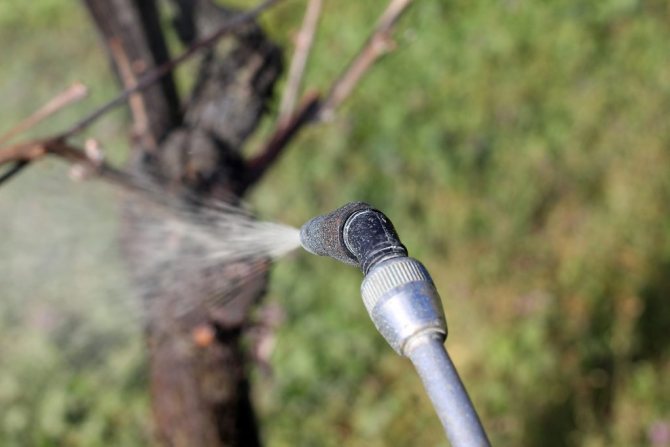

Additionally, you can make a mixture with urea. For this, 100 g of urea is added to a 3% solution. When carrying out root dressing, a special mixture is prepared. For its preparation, take 100 g of vitriol per 1 m² of land. Grape roots are carefully spilled with a similar solution. To eliminate iron deficiency, take 20 g of funds for a bucket of water.
It is necessary to spray the grapes in sunny, dry, calm weather. It's hard enough to wait for such a day in October. Therefore, after processing, 5 hours must pass without rain, otherwise the water will wash off the product.
You need to prepare the solution only in a plastic or glass container. In an iron bucket, the vitriol will react and ruin the mixture.
Important! When spraying, be sure to use personal protective equipment. You can process the vine using a special spray bottle or a watering can with a fine mesh.
After dropping the foliage and harvesting, the grapes are prepared for wintering. To do this, the stems are tied into a bunch, attracted to the trellis and all cut shoots and remaining leaves are removed.
The solution is prepared right before use, as it does not store for a long time. It is best for the gardener to wear gloves, a respirator and safety glasses. After the vine is prepared, it is generously sprayed or spilled with liquid copper sulfate.
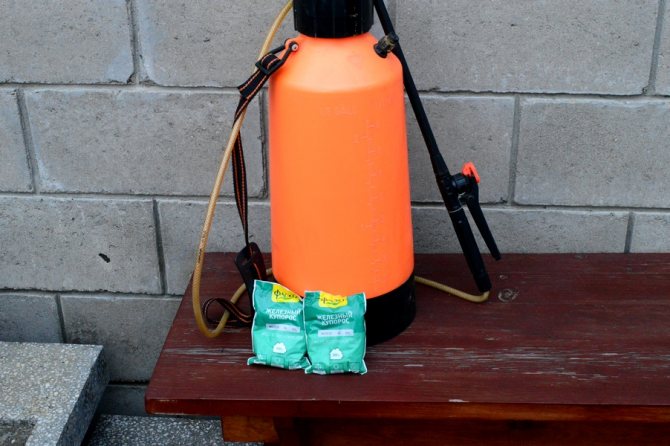

Occasionally, during inspection, you can find lichen and moss on the stems. It is difficult to get rid of them and for this you need to prepare a special remedy. This will require a 5% solution of ferrous sulfate. To it is added 1 glass of wood ash and 3 liters of boiling water. The mixture is allowed to cool and then used to treat the affected areas. It is abundantly applied to moss and lichens, after which it is left for 30 minutes. Then gently scrape off.
Sometimes bark damage can be found on diseased grapes. Such wounds can lead to the death of the plant. For their processing, a 1% solution of ferrous sulfate is used. It is applied to damaged areas and allowed to dry.
It is necessary to process the grapes carefully, observing the dosage, otherwise the plant will receive serious burns.
Common mistakes
Like any chemical preparation, ferrous sulfate must be used correctly.
If the instructions for preparing the solution are violated, irreparable damage may occur. Plants are threatened with death when the concentration of ferrous sulfate is more than normal. But when using small doses during processing, you should not wait for the proper result from prevention or treatment.
By spraying buds that are still asleep, you can stop their development. This is suitable for regions where spring frosts often return and destroy the vine. In the southern regions, after such treatment, the development of the buds will stop, and the harvest will not be received on time.
Iron sulfate does not cure bacterial infections. You should not waste time on processing, but it is better to replace the drug with copper sulfate, which is more effective against pathogenic microorganisms.
The acidic composition of ferrous sulfate does not allow it to be combined with agents based on zinc, copper, magnesium. All alkaline preparations are not used with iron sulfate. And laundry soap is not used in solutions. In combination with alkalis, there will be no sense in processing with iron sulfate. It is better to alternately spray with different preparations, observing a break of 2 weeks.
To treat the vines, take a spray bottle or sprayer, protecting body parts from contact with the working fluid. On the face - a respirator, hands - in rubber gloves.
Pets should not stay near the vineyard during disinfection treatment. After applying the iron sulfate solution, wash your hands with warm water and soap.
Taking into account the instability of the drug, disinfection is carried out with the drug in quiet cloudy weather. Rains can wash off the substance from the vine, and then you will have to do preventive measures again.
Safety measures during work
If you apply vitriol according to the rules and use only according to the instructions, this substance will be completely safe for the gardener. Although ferrous sulfate itself is not a toxic substance, it is best to take care of full compliance with all safety precautions in advance. This will help reduce the adverse effects on the human body and only benefit from the spraying procedure.
Care should be taken to:
- the granules did not enter the respiratory tract;
- the solution did not get on the mucous membranes - this can provoke burns;
- during the procedure, the face and hands were protected with gloves, as well as a mask;
- the solution was prepared in a glass container;
- between treatments, an interval of at least 10 days was observed in order to exclude damage to the leaves.
It is important to observe not only the rules for using vitriol, but also to keep it in a safe shelter, where it will not be accessible to children. You need to know what kind of vitriol and in what proportions to process the vines in the spring, summer or autumn in order to achieve the maximum effect.
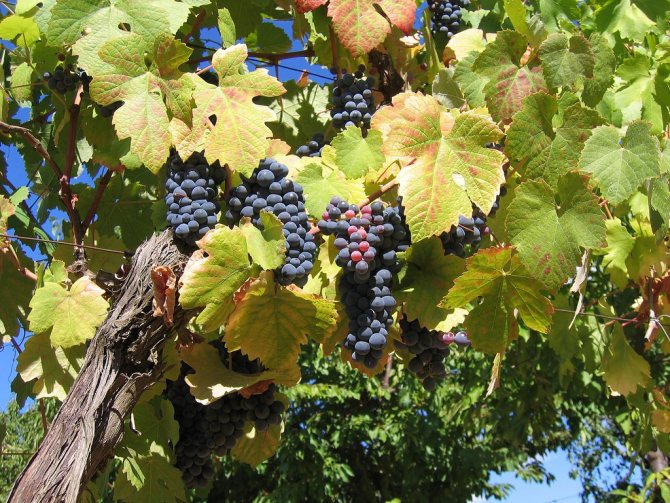

Grapes in the country

